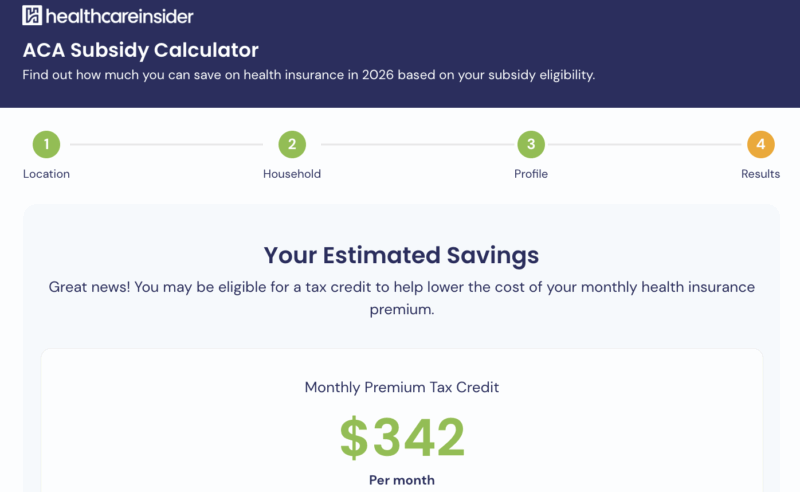
Written by Erica Block
Reviewed by Diane Omdahl
Expert Reviewer
We want to help you make educated healthcare decisions. While this post may have links to lead generation forms, this won’t influence our writing. We adhere to strict editorial standards to provide the most accurate and unbiased information.
Yearly out-of-pocket healthcare costs have more than doubled in the last ten years; luckily, there are things you can do to lower your healthcare spending.
If you struggle to pay your medical bills, you’re not alone. In our current political climate, it seems like everyone is stressing about the cost of their healthcare – and for good reason. According to a report by the Kaiser Family Foundation, the average premium for family healthcare coverage has increased 54% over the past decade, far outpacing inflation and wages.1
The high cost of healthcare in the U.S. is probably the only aspect of healthcare policy which both parties agree upon. For consumers, dealing with out-of-pocket costs is the most challenging and stressful aspect of managing care. Yet, even if we all agree that healthcare is too expensive, most policy reforms are designed to redistribute, rather than reduce, the burden of these costs.
The disconnect between political and consumer priorities is unfortunate, as skyrocketing out-of-pocket costs don’t only affect Americans’ wallets. When faced with higher out-of-pocket costs, Americans are wont to use fewer healthcare services, according to an Alegeus Healthcare research report.2 In other words, the prohibitive cost of healthcare is causing more Americans to elude clinics and doctors’ offices. Our healthcare system is underused, which negatively impacts overall health and mortality outcomes in this country.
What We Talk About When We Talk About Out-Of-Pocket Costs
Before we go into how to reduce your out-of-pocket healthcare costs, what exactly does it mean to pay “out-of-pocket”? Within the context of healthcare, out-of-pocket costs refer to medical expenses which you pay for yourself, as opposed to your insurance footing the bill. Generally, out-of-pocket costs include copayments, deductibles, and coinsurance for covered services, as well as expenses for services that aren’t covered by insurance companies.
Strategies to Reduce Your Out-of-Pocket Healthcare Costs
Whether you’re being hit with a surprise medical bill or are looking for novel ways to save money, we’ve outlined eight steps you can take to reduce your out-of-pocket healthcare costs and avoid billing overcharges. (Of course, you should never compromise your health for the sake of padding your wallet).
1. Research prices on health insurance plans and specific procedures
Even with ACA subsidies to make coverage more affordable, many Americans who buy health insurance through the exchanges spend more than 10 percent of their income on premiums, deductibles and other out-of-pocket payments, according to an affordability report by the Urban Institute.3 But “shopping around” for healthcare isn’t as easy as finding the best deal on a pair of Nike sneakers. The lack of price transparency in healthcare has been cited as the primary reason why Americans spend too much on it. If you don’t know how much something costs, it’s easy to overpay.
Still, many insurers have improved their price comparison tools in the last few years, using GPS technology to help consumers estimate the cost of care from in-network providers nearby. Aside from our own plan comparison platform, there are other tools, like Aetna’s Member Payment Estimator that calculates how much a procedure will cost at a range of local healthcare facilities. Likewise, companies like Amino and GoodRx also offer price estimate tools for consumers to use. When it comes to larger medical expenses, such as surgery or getting an MRI, it’s especially important to know the amount you’ll owe beforehand. If you’re having trouble finding the information you need, try calling local clinics or hospitals; ask to speak with the billing department. Then, inquire about pricing for the procedure you’re curious about.
Inquiring about the cost of healthcare may sound like an obvious piece of advice, but most consumers don’t do it. Critics of these tools are quick to point out that even if these online price comparison tools create more informed consumers, they don’t mitigate the high cost of care, as Helaine Olen writes in Slate.4 “The medical system in the United States is a complex beast,” says Olen. “The recipients of the services, even if they are the best shoppers around, have little actual control over the overall costs.” Even so, as consumers, we rarely make purchases without knowing how much something will cost. Why should paying for medical care be any different?
That said, you should never sacrifice quality to save a few bucks. Good health is priceless; paying more for a procedure is usually worth it if you’ll be receiving care from a reputable doctor at a good facility.
2. It pays to speak up. Discuss financial concerns with your doctor
NextAvenue.org offers a valuable lesson regarding healthcare costs: there are times when consumers can reduce their medical bills simply by asking.5 Many are unaware that it is possible to negotiate a lower price for healthcare services, particularly if there are other providers in your area who can provide the treatment you need.6 If you aren’t sure whether you’ll be able to afford the cost of treatment, ask your doctor how much you will be charged and whether there’s any room for accommodation.
“Many providers will negotiate on price—but generally not if people don’t ask.”
As healthcare affordability expert Mark Rukavina explains, “Many providers will negotiate on price—but generally not if people don’t ask.” Rukavina says many doctors are hesitant to talk about money because they don’t want to be judged for putting a price on patients’ well-being. Additionally, many hospitals will offer discounts to patients who pay their bill in cash, or in one lump sum.7 Contact your doctor or hospital’s billing office to learn if this option is available to you.
3. If your claim is denied, or if you receive a bill in error, be persistent and don’t back down until the issue is resolved
Get in the habit of requesting an itemized bill following any hospital stay or major procedure — and question unexpected charges. Ask for clarification if there’s anything you don’t understand.
If your medical bill contains errors
- Call your healthcare provider and your insurance company.
- Be polite–but persistent.
- Remember to document your phone calls and always note the name of the person with whom you spoke, the date, and the time.
- Be sure to follow up until your issue is resolved–even if it takes several months.
Although it can be frustrating to cycle through the process of calling, waiting, and being put on hold, it’s always best to keep your composure.
Insurance determinations are not always final, and plan holders can appeal a denial. Need some guidance navigating claim denials? The Wall Street Journal article “How to Appeal a Health Insurance Denial” offers practical advice and resources.8
4. Save the emergency room for emergencies
For life-threatening conditions and injuries, you should always head to the emergency room (ER). But if you’ve got a cold or a broken finger (and it’s not the middle of the night), visiting an urgent care center or scheduling a same-day doctor’s appointment will cost less than relying on the ER.
Even if you have health insurance, copays for emergency room care can exceed several hundred dollars. Urgent care clinics typically charge less than ERs do and many of these clinics take health insurance. Find out ahead of time which nearby urgent care and convenience care clinics are included in your insurer’s network. And if it’s truly an emergency, consider whether you really need an ambulance before calling 911.
5. Explore cost assistance or prescription drug discount programs
Even if you have prescription drug coverage through your employer, Medicare, or Medicaid, the cost of medications can add up quickly — especially if you take multiple medications. Whenever possible, request the generic version of a prescription drug, as the difference in price between a generic drug and a branded drug is significant. On average, a generic drug will cost about 85 percent less than its branded equivalent, according to data collected by the U.S. Food and Drug Administration (FDA).9
6. Choose doctors and providers who are in-network
Receiving care from an out-of-network provider is the most expensive mistake which healthcare consumers unwittingly make. The cost differences can be enormous.10
If you have health insurance, your insurance company has negotiated special rates with a network of healthcare providers. When you receive care from providers within that network, you’ll pay less for care– usually there’s a small copay. But when you receive care from an “out-of-network” provider, you’ll normally pay more. (Some PPO plans offer partial out-of-network coverage; HMOs don’t). Unsure whether a healthcare provider is inside or outside the network? Ask your insurance company. Read more here if you need help navigating your health insurance provider network.
7. Utilize telemedicine
Thanks to digital technology, it’s now possible to “see” a doctor, or receive an affordable medical consultation at the drop of a hat, no matter where you are. As high-deductible plans become more common, more consumers are taking advantage of telemedicine to save money on healthcare costs.
A number of platforms, including Pager and DoctorOnDemand, allow users to receive medical consultation through videoconferencing. Other platforms such as PillPack function as virtual pharmacies and also help consumers consolidate and/or limit prescription drug copays. Another cohort of apps have emerged, too, to make birth control more affordable and accessible. And, although this digital capability is certainly impressive in and of itself, the real beauty of these apps is that, collectively, they’re creating a more competitive marketplace for health and wellness services.
8. Use a flexible spending account or health savings account
If your employer offers a Flexible Savings Account (FSA) or Health Savings Account (HSA), consider using it to pay for your healthcare. Both HSAs and FSAs allow people who are insured to set aside pre-taxed dollars to pay for healthcare costs which fall under “qualified expenses,” including deductibles, copayments and coinsurance, and monthly prescription drug costs.
People with these accounts typically receive a debit card which they use to pay for qualifying expenses throughout the year. Typically, earnings on your savings in these accounts also accumulate tax-free, and withdrawals for qualified healthcare expenses aren’t taxed.
Thank you for your feedback!
Claxton, Gary, Matthew Rae, Anthony Damico, Gregory Young, Daniel McDermott, and Heidi Whitmore. “2019 Employer Health Benefits Survey.” Kaiser Family Foundation, September 25, 2019 (accessed March 2020).
Alegeus Healthcare. “Moments of Truth’ Research Report.” info.alegeus.com. (accessed July 2017).
Blumberg, Linda J., John Holahan, and Matthew Buettgens. “How Much Do Marketplace and Other Nongroup Enrollees Spend on Health Care Relative to Their Incomes?” Urban Institute, December 2015 (accessed July 2017).
Olen, Helaine. “A Failed Cure for Health Care Costs.” Slate, January 9, 2017 (accessed July 2017).
Fivecoat-Campbell, Kerri. “7 Ways to Avoid or Reduce Medical Debt.” Next Avenue, November 7, 2016 (accessed July 2017).
Mayer, Caroline. “6 Ways to Negotiate Lower Doctor Bills.” Next Avenue, January 15, 2013 (accessed July 2017).
Pratini, Napala . “5 Ways to Cut Medical Costs.” U.S. News & World Report, March 17, 2014 (accessed July 2017).
“How to Appeal a Health Insurance Denial.”Wall Street Journal (accessed July 2017).
U.S. Food and Drug Administration. “Generic Drug Facts.” fda.gov (accessed July 2017).
Andrews, Michele. “Out-Of Network Care Is Expensive But A Couple Of New Options Help.” Kaiser Health News, April 16, 2012 (accessed July 2017).


 by
Diane Omdahl |
Updated on
August 18, 2025
by
Diane Omdahl |
Updated on
August 18, 2025 




